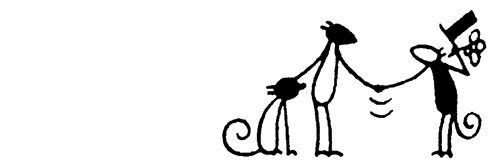
Dylan Williams: My first question is to have you introduce yourself...
Chris Ware: Going around the room or something?
Williams: Just... I don’t know... you’re Chris Ware and what do you do?
Ware: [laughs] I don’t know, what do you mean, on a regular basis?
Williams: Okay, what do you do to make money besides comics?
Ware: That’s it.
Williams: Really.
Ware: I’m living really cheaply. I sell my original artwork. Sometimes I’ll occasionally sell paintings, but those take a really long time to do and I don’t like selling them. I’ve done occasional illustration here and there, but I’m really bad at it. I don’t like doing it too well; it’s really hard for me to work with someone else’s idea.
Williams: I know how that is.
Ware: Mostly I’m just kind of living month to month, until it seems like I really have to get a job. I’ve been doing alright now. I’m just lucky, I guess.
Williams: That’s great.
Ware: I guess, yeah it is, it’s really not a place to make money.
Williams: Dan (Clowes) seems to be doing pretty well.
Ware: Yeah but...
Williams: …but he’s been at it forever.
Ware: Well, he deserves it too, because he’s honestly really great.
Williams: ...okay, next question: Where are you from artistically, what schools...
Ware: Artistically...
Williams: Yeah what (forgets what he meant by the question) schools did you go to?
Ware: I went to the University of Texas in Austin, and then I went to the Art Institute in Chicago, where I did not finish my MFA. I supposedly graduated a year ago, but I still have six hours left. Pretty stupid.
Williams: What publications have you been in?
Ware: In Austin I was in the Daily Texan for five years.
Williams: Wow.
Ware: It was where I did most of my stuff. It was when I was in school. I did a weekly or a daily strips there. There were a lot of cartoonists down there at the time. There are still some there too. I would say at one time there were twenty cartoonists all working on a regular, either daily or weekly, basis. It was kind of fun.
Williams: That was going to be one of my questions; what was living in Austin like? There were so many people down there.
Ware: It was really nice.
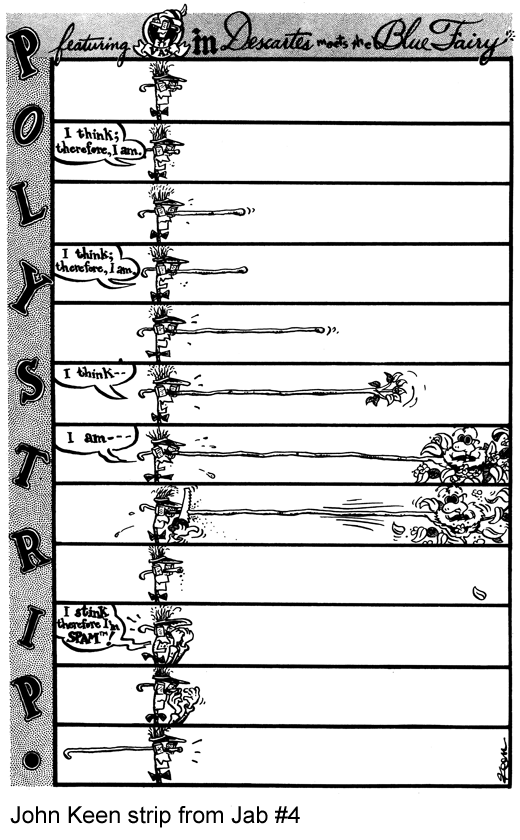
Williams: Did it help you to be a better artist yourself, being around artists that much?
Ware: Probably. One of my best friends down there, John Keen, he and I started doing strips more or less at the same time. He started a little bit after me.
Williams: What has he done stuff in?
Ware: Wait, say that again.
Williams: What things has he been published in?
Ware: He hasn’t been published around too much. He had something in National Lampoon once, which is what always irritates me. There have been a number of articles written about Austin cartooning and he’s always left out, even though he did more than anyone else, since he wasn’t published afterwards, because his stuff is too weird. Actually, strangely, James Sturm did a book that he and I were in, a long time ago. I guess you could count that.
Williams: What was the book?
Ware: I don’t remember the name of it. He (Keen) experimented a lot. We would at least convince ourselves that we were fairly miserable people, and would try to get that sense into the comic strip. He did it better than I did, I think. (He did) things you’ve just never seen before.
Williams: It really makes you push yourself when you’ve got friends that are doing it. The whole Puppy Toss thing is like that too.
Ware: Plus, when you have regular deadlines like we all did, we would all feel terrible at the same time.
Williams: (Laughs) I guess it’s not too great.
Ware: No. It was. I really missed it a lot when I first got up here (Chicago). I didn’t draw anything regularly for about six or eight months and then I started doing stuff in New City. All of a sudden I was alone doing it, and there was really no one to talk to. I would hang out with Dan Clowes and Gary Leib and Terry Laban and Archer Prewitt, and we’d sit around and draw, basically, pornography. That was kind of fun, but it wasn’t the same thing.
Williams: Was it those little mini-comics?
Ware: Yeah.
Williams: There’s a whole bunch of them. We sold ‘em at Comic Relief.
Ware: (Dan Clowes has) got all the originals. I’m sure we could just crank them out. They’re all purely... fundamentally valueless. They’re kind of funny drawings, and of course (Dan’s) just kick the ass of everyone else in there. I don’t know how that guy could... every drawing he did was just a mind bender, and I was just trying to get a hand to look right.
Williams: What kind of family did you come from? Was your family artistic? Basically what I’m asking is: did you grow up with art?
Ware: (Laughs) Well, I don’t know. No one ever tried to tell me what not to do. My grandfather and my mother were in the newspapering business, as was my great-great grandfather.
Williams: In general or strips?
Ware: My grandfather wanted to be a cartoonist, and he ended up being a sports writer and then managing editor. My mom wrote... was a reporter and an editor too. So I grew up always going to the art department, seeing these guys airbrushing photographs or doing cartoons, and I was just amazed. I really wanted to do that. There were a lot of books lying around the house that my grandfather got free from the syndicates in the fifties. I’d sit around and read them. He’d get letters from his friend that were... he used to correspond with Walt Kelly and people like that. There was a cartoonist that lived down the street. I think that guy in the Comics Journal mentioned this, which is weird because I never told anyone this before, but he was an old cartoonist and I used to go to his house and watch him draw. He was kind of an old guy that drank a lot; it was kind of sad. He drew really well; I just... I was amazed. His stuff still... I see it, we’ve got a couple in my house... my mom does, they hold up really well. He’s got a looser line than anyone else doing editorial cartoons now, by far.
Williams: Yeah, it seems there are a lot of alcoholic cartoonists.
Ware: That’s an apt description of pretty much everyone: fat, balding, alcoholic, cigar smoking dead people eventually. It’s kinda sad. At least we have something to look forward to, right?
Williams: Yeah.
Ware: I need to start learning how to play golf pretty soon. Avoiding our wives.
Williams: What are your influences? Clowes told me that you like McCay and somebody names J.R. Williams, who I’d never heard of, except for his counterpart nowadays.
Ware: That’s funny that you’d mention that. He did a strip called Out Our Way, none of which I have anymore. I gave ‘em all to David Collier because he loves it so much. So I mailed them off to him, but he’s not actually one of my favorites by any means. He’s okay. Probably my very favorites would be the typical: Robert Crumb and George Herriman. Cliff Sterrett particularly. Frank King... a lot. He did Gasoline Alley. I think his work is wonderful. Lyonel Feininger. The stuff I look at a lot is things like that. I don’t look at them as much as I used to.
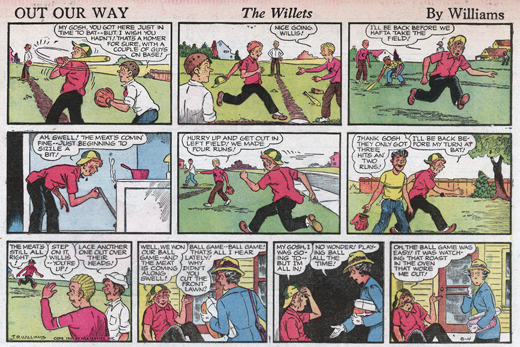
Williams: Did you see how they are reprinting Barney Google?
Ware: No, I didn’t.
Williams: Yeah, I think Kitchen Sink is doing it.
Ware: Wow, that’s good. I wish they’d reprint some of the other stuff. I’m upset that the Polly and her Pals thing didn’t take off. They always reprint that Steve Canyon crap. It’s not crap, but I hate the fact that all those adventure strips are supposed to be so wonderful.
Williams: Do you know who Noel Sickles is?
Ware: No.
Williams: He was the guy Caniff got it from. He’s Toth’s big influence. He’s this really obscure guy who kind of started all that.
Ware: Wow, that’s weird. There was this guy named Ray Gotto, who did Ozark Ike. Have you ever seen that? It’s like Charles Burns in the 1940s.
Williams: Wow, no.
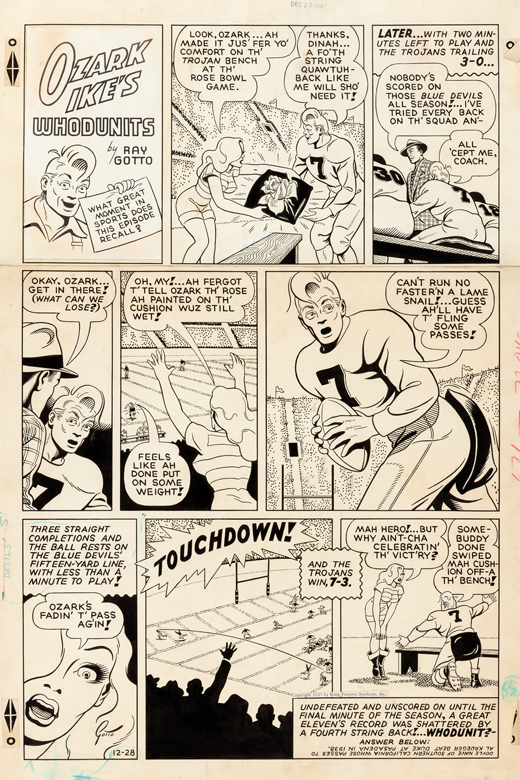
Ware: They’re great. They’re really inspiring. You could probably find it in one of your comic book stores there. Just look for Ozark Ike. They’re really neat. He does goofy stuff, like sound effects bouncing off people’s heads, and it’s sort of Nancy-like, in that he used a lot of the same poses, the three-quarters view. He has the same kind of pseudo-woodcut brush line that Charles Burns and Caniff’s stuff sort of hearkens back to.
Williams: Do you like Burns?
Ware: Oh yeah, there’s very few people I really don’t like, that I don’t get much out of.
Williams: Who don’t you like?
Ware: I don’t know. I don’t really want to say. It’s not that I don’t like them, it’s just that I don’t read them. I don’t really get anything out of them. I think Dan Clowes is great, and I think Ben Katchor is probably the best writer in comics ever, by far. His stuff... I don’t think enough attention can be called to it. He’s doing things with it that no one else has ever attempted. That sounds corny because people say that about the lamest crap all the time, but he really is. He’s a brilliant writer. He’s putting words and pictures together in ways that I’ve never seen or thought about before. In very subtle, metaphorical ways of sophistication that comics have honestly never seen, and that’s why I think most people don’t read it, because they just don’t get it. There’s always some sort of obvious connection, but when you read his stuff continually, there’s a profound tragedy to it. They’re wonderful.

Williams: Besides that one book, there’s not much of his stuff in print.
Ware: No, not unless you can get it regularly, and I’m disappointed that The Stranger in Seattle chooses to carry it so infrequently. We carry here in New City, which is great.
Williams: I’ve never even seen New City. I’ve heard so much about it. Is it nationally distributed at all?
Ware: You can get a subscription.
Williams: It’s got your stuff in it...
Ware: Yeah, big deal. It’s usually off-register anyways.
Williams: That was another question. How do you deal with all that? Somebody told me that they will tell you at the last minute what the color is going to be (Ware’s strip appears printed in one or two colors, mostly).
Ware: God, where do you hear all these things? Well, basically it’s true. They tell me on either Friday or Saturday. They tell me what the colors are, and I kind of base the content of the strip around that. Lately I’ve been doing a continuing story which I’m sure is just completely boring to everyone. I mean, it’s even boring to me when I look at it now.
Williams: Because you drew it.
Ware: Yeah, but I was trying to be objective, and I thought, “This is just dull. Nothing is happening.” Then the colors are odd. If they’re not necessarily a primary combination or at least a complementary combination, then I’ll do something a little more experimental or something a little stupider. Which is what generally gets more response anyway. I try to vary it, and if the colors stay the same for a long period of time, I’ll vary it anyway, just to keep myself and whoever may happen to be reading it interested. There’s so much regularity. I still don’t understand why comic books have to be the size they are now, because they’re based on a mother-sheet size that was specific to the printing industry at a particular time, and is no longer the form.
Williams: Yeah, comics today...
Ware: They’re hideously ugly. I mean, even if you take a piece of paper, fold it in half and cut it down to comic size, it’s an ugly thing. It’s like sans-a-belt pants, they’re fundamentally ugly. No matter what color or what’s printed. I don’t understand why.
Williams: I really like digest size.
Ware: Yeah, I do too. Fantagraphics has been really nice. With every issue of my comic book, they are letting me do whatever I want, basically.
Williams: How many issues do you have planned out?
Ware: They’re talking up to at least eight now. The next issue (#2) is going to be really big, and then the third issue will be small and thicker. The fourth issue will be big again. The fifth issue will hopefully be in a horizontal format. It’s really nice, and they’re being cool about it. The next issue will be on white paper and then the third issue will be on newsprint.

Williams: They’re letting you pick the paper weight and everything?
Ware: ...Within budget. Kim Thompson called me last week, and the second issue was going to be in newsprint because of it’s size. Originally they were reluctant to do it big at all, because they didn’t think retailers would take it, but now they are being really cool, and thinking maybe other people would want to do something big. It’s going to be 11 x 14 inches. Originally it was supposed to be on newsprint and (Thompson) called to say that he found a printer that would do it for $150 more, on white paper. He asked if I would want to do that instead. They call me every once in a while to ask me stuff like that, and I think, “You guys are not my publishers, you’re nice guys or something.” He found out that he could save money on the first issue and he called me to ask how I wanted to spend the extra money, so I got an extra color. Rather than keeping the profits for themselves, they try to make a better product, which I don’t see anywhere else in the industry.
Williams: Drawn & Quarterly does a good job.
Ware: Yeah, you’re right. The stuff they’ve just been doing with Chester Brown and all that.
Williams: It’s still at comic size.
Ware: ...But their paper stock. Even though the ink kind of stinks. I think that’s soy ink. Did you notice that? It kind of smells like dirt when you open it up.
Williams: Yeah, that’s true.
Ware: I was surprised how much that affected me. I’ve asked everyone that, and they go, “Yeah, that stunk.”
Williams: I like the way they feel.
Ware: When I picked up the latest issues of Palookaville and Yummy Fur, I felt ashamed ‘cause they looked so good.
Williams: Yeah, that’s another question: do you like Seth’s stuff, or how do you feel about it?
Ware: I think he draws really well.
Williams: You guys have a really similar bent towards antiquity.
Ware: Someone else told me that.
Williams: And that clean line too.
Ware: Clean line...boy. I just had a copy of his latest book open the other day ‘cause I like the way he composed a panel. He used a grey tone, a black and white. That’s basically the way I work too. It’s almost a guaranteed problem manufacturer, and he seems to solve it really well.
Williams: With the grey tone...
Ware: Just having the limited means with which to work. His stuff works really well, at least visually.
Williams: What do you think about Krigstein?
Ware: Yeah, sure, I was always pretty amazed by the guy. I think everyone is. I wish someone would put out a book of his stuff. He did paintings too. I almost bought one. They had a show of them right after his death. They’re really pretty bad.
Williams: Really?
Ware: They’re sort of like late-modernist chromatism, or something. One of those weird theory paintings. Apparently his wife won’t sell any of his comic artwork, which of it he had. Who cares? It’s nice that they’re reprinting stuff. That’s the great thing about comics.
Williams: You and he have a really similar approach to time. I don’t know if you’ve noticed it.
Ware: No.
Williams: Just how you dissect a moment and all that.
Ware: It’s getting worse with me. The weekly strip now is almost in real time. However long it takes you to read it is how long it happens in the strip. It’s getting worse. That’s what I mean when I say I think it’s getting boring. It took eight panels for a character to put his pants on last week. Actually that’s wrong. It took more than that. I got him on the toilet for fifteen panels.
Williams: I think it’s really necessary. I don’t think enough people are aware of that stuff.
Ware: I’d like to make something... if you look at it, you can’t help but read it. As soon as you start looking at it, you’re reading. Once you go from one panel to the other, I want the character to be alive on the page. The way that people move their bodies and the conversational rhythms that occur, and hand gestures when people say things. They’re constantly putting their hands up to their face, scratching their noses, shifting in their chairs. I think that’s really important. If you can work that into a strip, not only can you sometimes indicate more about a character, you can create more of a sense of real time. Sometimes I don’t even care what the character’s saying, as long as I’m getting those gestures down. I think it’s really important. It’s pretty easy to do in a comic strip. A lot of people don’t do it though, they just draw little stick figures. Basically all they are is well drawn stick figures standing there. You know, it’s the Saturday morning cartoon effect, which can work, but even Nancy had a quality of gestures. Peanuts is one of the best for that.
Williams: They’re so great. I just went out and bought a bunch of those... they’re so neurotic.
Ware: I agree. I used to sit around and read those all the time when I was a kid. I used to color them in with crayons, for what it was worth. I don’t know why.
Williams: Here’s one: Dan Clowes said you drove from Chicago to New Mexico to visit George Herriman’s house.
Ware: I flew to Arizona and stayed with my great-aunt...
Williams: He said you travelled. I probably just heard what I wanted to...
Ware: I stayed at my great-aunt Tootsie’s house. She lived in Scottsdale, Arizona, in one of the earliest subdivisions there. Then I rented a car and drove out to Monument Valley, and just tried to find some evidence of where he was. I actually found the hotel resort that James Swinnerton used to stay at.
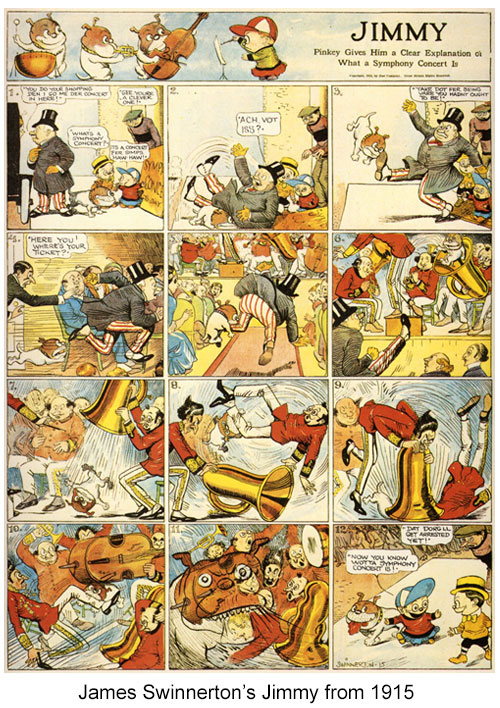
Williams: Who’s that?
Ware: J. Swinnerton. He’s a cartoonist. He’s not the first daily strip cartoonist, but one of the first. He did the tigers with the little round heads and big eyes. He’s the one who got Herriman to go out and stay there. Herriman never lived there, he would just go out on summers. Later in his life, he hardly went out at all. Swinnerton just went out there because he was diagnosed with some sort of weird lung problem. If he didn’t go out there he would die, apparently. He ended up living fifty more years, or something nutty like that. Herriman would go out there and stay, and I found that, strangely enough, a lot of the businesses were named after the people we would stay with, which is the Wetherills. There’s a Wetherills Hotel, and I met the guy who owned it, and he had no idea, of course, who any of these people were. These people actually started Kayenta, which is the trading post there. I think in that book on George Herriman, they say that undoubtedly if Kayenta had a post office he would never have left. Well, it does have a post office, of course, and it has had one for a very long time. In fact, there was a photograph out there of the post office in the 1920’s. It’s really nice. It’s an amazing place. He mostly lived in California. He had a pretty rotten life, I guess. His wife and his daughter died on the same day, a year apart. I think they were both auto accidents. He had a pretty nice sense of the injustice of life.
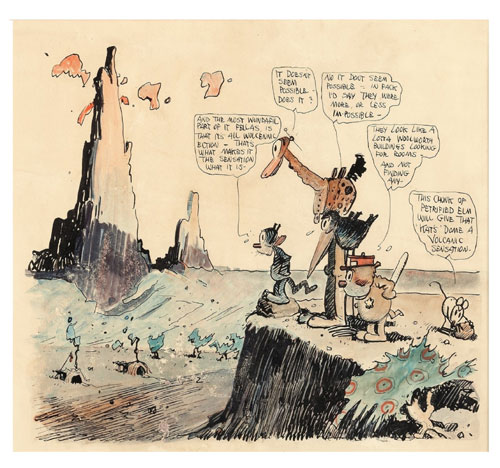
Williams: Yeah, his strips just speak.
Ware: They were pretty amazing. It’s amazing because no one can imitate him without looking just like him.
Williams: That’s one thing I find annoying, the amount of people who try and draw like him, without looking just like him. It’s homage and all that, but I don’t know...
Ware: Strangely though, if you look at his strips, and you look at the cartoonists of the time... his style of drawing is much more accomplished than it appears, but it’s not that different than a lot of the... it’s full of the same conventions.
Williams: Like Bud Fischer and those guys?
Ware: Especially Frederick Opper. They’re very similar.
Williams: Who’s that?
Ware: He did Happy Hooligan.
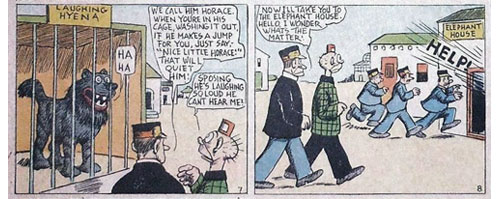
Williams: You really know your history.
Ware: Well, I really like that stuff. The way that they drew hands. The way that they composed a panel. Even if you look at a lot of strips, there’s a lot of cliches that pop up; there’s the house in the background with the tree next to it, and the little antenna coming out of the house. I think Segar used it a lot. The one that I’ve seen the most is where someone’s standing in a house, Cliff Sterrett used it a lot, it’d be the corner of a room with a vase, and then in the background there would be a curtain drawn back with a circular window with a cross shaped window bar. It’s not like I’m looking for these things, I just started noticing that they all drew this thing. You find it in every cartoonists strip.
Williams: Did they all know each other?
Ware: Yeah. They all worked together a lot, for most of the same papers anyway. Winsor McCay and Cliff Sterrett, all those people worked for the (New York) American. Herriman, Tad, and I’m getting fuzzy here, it’s been a while... they all worked for the same people too. He might have worked with Winsor McCay too, but I don’t know what effect they had on each other.
Williams: I just got to watch the animated Winsor McCay video. There’s this part that really reminded me of when you had Jimmy Corrigan alone on an island.
Ware: What was that?
Williams: In Gertie the Dinosaur. It’s this one scene, where Gertie’s by the sea shore and there’s some sea monster. There’s a cliff and the hills, like you had.
Ware: Wow.
Williams: Did you know that?
Ware: No. The first Gertie cartoon?
Williams: It’s the one where he tries to get Gertie to lift his leg, or her leg.
Ware: That’s the first one he did, right?
Williams: Yeah.
Ware: I guess I stared at those drawings a lot, so probably they’re stuck in my head, plus it’s a kind of easy thing to draw.
Williams: So my next question... when the Journal reviewed your stuff on that one little page there...
Ware: That’s like a Comics Journal one page infomercial.
Williams: ...they called you meticulous, and then later on in their catalog they called you insanely meticulous. How do you respond to that kind of stuff?
Ware: I think it’s flattering.
Williams: That’s a really conscious thing you’re going for?
Ware: No. I just am that way. It makes me angry to see so many people who do things that don’t care about what they do and are purposely flippant, purposely put out things that are like, “Oh, I did this in two hours. Fuck you.” Which is the overall effect of it.
Williams: So it’s almost like they don’t care.
Ware: I don’t see why anything that takes time, care, effort and that kind of application, should be labeled as either anal retentive or some other negative word.
Williams: My stuff is like that too. Not always, but when I sit down to do it, I’m really “anal” about my lettering and stuff.
Ware: You’re not being anal. You’re being careful. It’s just a word used by people that can’t draw and have no ideas to justify their dislike for people that are intelligent, careful, and want to make something that’s worthwhile, I think. Of course, that’s probably a rationalization too. Forget it.
Williams: Do you re-draw stuff?
Ware: Sure.
Williams: Like if you draw a page and it’s all wrong, would you go ahead and re-draw it?
Ware: It depends. If I’m doing a weekly strip, I’ve kind of gotten past doing that, because I have to appear. I might be doing a story like the storyline I’ve been doing for New City. I’ve actually thrown pages out of it, without telling any of the readers, gone back and re-drawn the page out of sequence, and just run it without telling anyone. For what it’s worth, no one knows what’s going on anyways.
Williams: That’s one of the most interesting things about having readers, especially in a newspaper strip, is that you get to mess around with how they digest things.
Ware: That’s true.
Williams: Would you rather be doing a comic strip than actually doing a comic book?
Ware: Oh, I see: I’m not really... no. I can’t do anything without having some sort of deadline, otherwise I’m too lazy. I wouldn’t get it done. The comic strip allows you to have a weekly deadline and then forces you to get something actually done. Then I can go back, review it and edit it. If I was just doing a comic book, I would run tons of junk in it. This way, I can at least edit it down to a point where I think it’s concise. Otherwise, I’d just throw a bunch of junk in there that wouldn’t be worth looking at. I just want to make it as compact as possible, put as much stuff in there as I can without having it be oppressive. Make it worth it. Cartoons are the perfect medium for making something so dense that you have to read it over and over again. At least the way my mind works. I don’t know about other people, but if I read something in a book about a character, say a Faulkner book, and a hundred and fifty pages later the character comes up again, I think, “Wait a minute, I’ve read that name before.” Then you start going back and think, “Let’s see, the pages in my left hand were this thick, and I remember reading the word on the upper left hand corner.” But in a comic book, you immediately have a recognizable visual reference, so that you can make those pictures much more dense. I like to have something where, if someone was reading, they could say, “Oh, wait a minute.” They could turn back, and the could know exactly where something is. Those kinds of interconnections, I don’t think are possible in any other medium, especially not film, which I’m sick of cartoons being compared to.
Williams: That was something Krigstein talks about in this one interview. He says how Eisner was doing comics in terms of film.
Ware: I still do not understand the appeal of Eisner’s stuff. I really don’t. It seems so melodramatic. Over thought and overwrought! The idea of putting a comic book in a newspaper (which Eisner did with his Spirit sections in their original presentation) I think is really cool.
Williams: He did have some really neat concepts as far as over-all stuff goes. I like the soap opera-ness of his stuff. How there are recurring characters.
Ware: Right... Where did you read an interview with Krigstein.
Williams: In that Squa-Tront.
Ware: What! Really! No!
Williams: There’s a whole Squa-Tront devoted to Krigstein.
Ware: What’s the name again?
Williams: It was the E.C. fanzine in the seventies.

Ware: What’s it called?
Williams: Squa-Tront. It was something an alien said in an E.C. science fiction comic. The interview is totally insightful. I think it was done in the sixties too, so it’s while he was still...
Ware: Aware.
Williams: Have you seen the stuff he did after E.C.?
Ware: No, I have never really tried to...
Williams: That stuff is great.
Ware: I feel so ignorant. What companies was he doing it for?
Williams: For Timely, you know, the Marvel / Atlas thing. They’d give him these four pagers and he’d cram in seventy-two panels on four pages or whatever. He set all these records... actually, it’s kind of like your stuff.
Ware: Wow, I was not aware of this.
Williams: That’s what I’m saying about the time stuff, ‘cause he was really into that dissecting the moment, looking at it from different angles.
Ware: This is like revelation time.
Williams: I was looking at this boxed E.C. crime set, and there’s this other artist named John Alton. He looks like your stuff too, but he didn’t have the time thing down. Stylistically, he had that fine brush thing.
I’m interested in the specifics of your storytelling: the impact of time, the way it’s laid out seems thoroughly conscious. You really think it out. Do you script your stuff out?
Ware: No.
Williams: You just do it “stream of consciousness?”
Ware: Uh-huh.
Williams: WOW! Do you lay it out?
Ware: No.
Williams: You just do it right on the pages?

Ware: Uh-huh. There’s nothing to wow about, because I think it’s much easier that way. I don’t see how anyone could sit down and try to think ahead of themselves. I would create the most boring stuff if I sat down and scripted things, because the sort of associations that occur while you’re drawing, and the ideas that you get, are the real ideas. I don’t think it’s possible to have a fundamental idea when you start out scripting or laying out a strip. I think that’s silly. What’s the point? You’d get bored, first of all, drawing it. I never know how any of my strips are going to end at all. I start out with a blank page. I might make some basic decision, like, “The first row will be three and three-quarter inches. Tall panels and maybe I’ll stick one in that’s taller.” Then as I go along I might draw something in the background and think, “Wow, I’ll use this.” I’ll draw it again, or light it up with another image on the page, or I might re-draw something... As far as in the long-term storytelling, the source of associations that you want to occur in a story can only happen if you let them occur naturally. Your brain is a very organized thing. I think mine is, I hope, because things keep on popping up and I notice them. I might have a vague idea of what I want to do. The only way those things can come together... sometimes I’ll be thinking, “I’d like to do this...” and then I’ll think, “Oh wait, I already did that. I forgot.” It’s just more fun. I hear about people writing stuff and... I think Dan Clowes approach to it is pretty good. He writes really fast, which I think is a similar way to do it, plus, I don’t know if this is true or not, but Terry Laban told me that (Clowes) draws, pencils, and inks one panel at a time. He doesn’t actually do the whole page. I think that’s the way the Hernandez brothers do it, but I’m not sure. I don’t know, but for me, I like to have the all over the page be much more of a composition. I’m writing, with a pencil. Drawing and writing at the same time, I can do that. Then, as I ink it, I can do the whole thing at once. Does that answer your question in a really stupid way?
Williams: No, that’s great.
Ware: I just don’t see how anyone can do it; scripted out.
Williams: People have done it forever. I know it’s because of the industry, but they’ve done it for so long. It’s like this established thing.
Ware: I don’t see why... You look at Herriman’s originals, and I’m almost positive that he hardly sketched anything. I know I read in the book that he lightly sketched, but I’ve examined them so closely, and I hardly saw any. For a while, I didn’t draw in pencil at all. I’d just draw right on the page with ink. That had its limitations.
Williams: Yeah, Alex Toth doesn’t lay his stuff out at all. Do you know his stuff?
Ware: I’m vaguely familiar with it.
Williams: He did Space Ghost. There are just a few artists that I know of that didn’t lay their stuff out. I think it gives you total spontaneity.
Ware: Last week in my strip, I definitely had some ideas that I wanted to get worked into the story, and I never got around to them. I just ended up the strip... everything that ended up happening in there I didn’t expect to happen at all.
Williams: Is that the one where he’s putting on his pants?
Ware: Yeah, right. Maybe it’s a stupid way of working. I don’t know. I was reading about how Vladimir Nabokov would compose using three by five index cards. He’d keep reordering them with notes and such. Gustave Flaubert, I’ve read his correspondence with George Sand. When he was writing Sentimental Education, there’s one part that happens where the character’s supposed to be in a forest. He wrote seventy-two pages of description simply of the forest itself. He spent a week deliberating on what he would use to describe long legged insects. He didn’t like the French word for “katydid,” because it had a particular assonance that fouled the poetic effect of the paragraph that it was in. So, he wrote to George Sand if she could come up with a word. He finally decided on long legged insects, and of course, edited the entire seventy-two pages down to four pages, and that part was left out. Different people work in different ways. William Faulkner wrote Light in August, which is one of the great books, I think, in four months. That’s just an incredibly involved, beautifully constructed book. It’s just amazing. Who knows...
Williams: Yeah, I think it’s just up to the individual for the most part. Aesthetics...
Ware: Not even that. It’s what drives you. I just imagine William Faulkner furiously writing, and I imagine Gustave Flaubert practically having to force the pen into the paper, it was such a painful experience for him to do it. He was just constantly depressed. I guess Nabokov, he seemed like a pretty funny guy, actually; collecting butterflies and kissing his wife. He seemed like a really happy fellow.
Williams: A friend of mine pointed out that you have a real musical quality to your work...
Ware: Wow. Who’s that? I like them. That’s really nice. I’ve tried to get that in there for years, and then I figured it was pointless.
Williams: Yeah, you can almost see the notes. It’s partially ‘cause they’re so like symbols, your characters. They represent things...
Ware: God, well that’s really nice. That’s actually how I’ve thought about it for years. I did strips without words for years, specifically to try and get at that: the music of a cartoon. I just wanted to have the panels each... as you know from what you’re saying, when you read a comic strip, even if there aren’t words, it creates tones in your head. It creates a sound. It creates a rhythm, and I was trying to get at that sort of feeling when you’re reading. You draw a character walking, and it’s kind of like, “dah-dun-dah-dun,” and then if he runs really fast, then you draw those lines above him, so he looks like he’s jiggling, that has this “duddle-duddle-dut” sound, and then if he stops, it’s like a beat, and if he turns his head, it’s like a half-beat. If you put those things together, like you’re saying, it can almost create this... I don’t know how to explain it. It sounds completely absurd, like we should be in some old age home talking about it. So I just started using words because I wasn’t getting anywhere with mice.
Williams: Was that when you had the potato guy with the eyes falling out?
Ware: That was when I started doing it, then I went to mice.
Williams: The Quimby stuff. That potato guy looks a lot, sorry to use comparisons so much, like Watterson’s stuff.
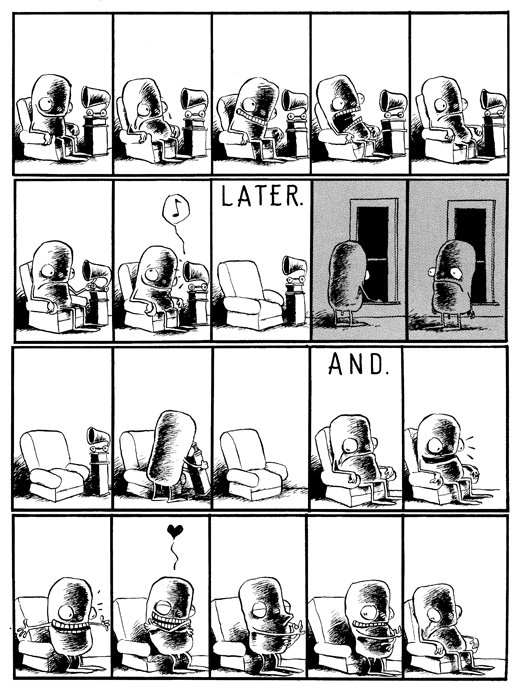
Ware: The one from Raw, you mean. Yeah, you’re right. That is a horrible... that’s redrawn from one that I’d already done, and I just completely ruined it. The good thing is that the original art was lost in the mail, so I got paid by the insurance company.
Williams: Oh... the friend of mine who pointed out the musical thing, pointed out that there’s even a pick-up before you start your stories. There’s a little thing that leads you into the first beat.
Ware: Weird. Is this person a cartoonist?
Williams: No, he’s actually a musician. He works at Comic Relief. His name’s Mark Stichman (credit where credit is due department).
Ware: Well, tell him thanks. No one has ever mentioned that, but that is the way I think about work more than pretty much anything. He’s a smart, observant fellow.
Williams: He’s been into comics for ages. He’s a nice guy.
Ware: I think Robert Crumb said in some interview that he thought a lot of cartoonists were musicians. Cliff Sterrett played, I think, string bass. Crumb plays the ukulele. I’ve tried to play piano for years now. There are different analogies to music. There’s analogies - this sounds stupid and sounds like I’m completely nuts, but there are analogies between cartoons and every other artform that exists. I mean dance, music, writing, art... everything. It’s all there, and you have to understand it to a certain extent. The way the human body moves, how to get it down on the page, and how to get a musical rhythm. How to create a story that’s convincing. How to set a place. How to create a drawing that’s either empathetic or gives you distance. Everything. It’s mind boggling when you think about it.
Williams: That’s why I like it so much, because you get to try everything.
Ware: Me too, and then there are people who try to tell us that we’re idiots.
Williams: Gil Kane once called comics, “some commando art training camp from hell.” That’s a typically Gil Kane way of saying it, but... it’s really true. You have to know how to do everything. You can’t just be a frustrated filmmaker, unless you are Jack Kirby.
Ware: The thing is that all the strips that are in the paper, what most people consider comics, I don’t even think of as comic strips anymore.
Williams: Peanuts is okay.
Ware: Yeah it is. I have to agree.
Williams: His wiggly line’s pretty cool.
Ware: But so much of it is just... I could see why people think it’s just this tossed off kind of thing. So many of them rely on cliches and visual ideas that they just developed and used over and over again. It’s embarrassing. I don’t think that’s what cartoons are. I don’t think that they’re the same idea over and over again. That’s one way of approaching it.
Williams: Yeah, even Nancy would have something different... Nancy is just great.
Ware: They’re amazing.
Williams: There’s a mythology to your character. Do they represent anything in particular? Are they autobiographical, or are they just concepts?
Ware: I don’t know how to answer that. They’re just what I can actually draw that doesn’t look stupid, basically.
Williams: Well, is Jimmy Corrigan at all autobiographical (boner question)?
Ware: Sure, just like everything else is. I’ve had friends accuse me of being a liar, because, “You’re not really that sad and lonely.” First of all, how do they know, and at one time everyone feels that crappy. I don’t want it to be that, “he’s just this crappy, depressed character.”
Williams: Jimmy really does make people sad.
Ware: Crap, yeah, I bet. It seems like so many things being done now don’t admit that humans are going to look at them - or listen to them, like the music we have, and are forced to see in movies.
Williams: But that’s what the market demands (sarcastically).
Ware: Plus a lot of cartoonists seem to have this really coarse, snotty adolescent attitude. I just get really sick of it. There are a few, like Chester Brown or Joe Matt, that show there are emotions in life other than just feeling nasty about everything, or hateful.
Williams: I think it’s really interesting that a lot of your characters can be really really funny, and then you have this really sad, mopey character.
Ware: I guess he doesn’t seem that sad to me. I guess there are just moments in everyone’s life when they feel really sad. I always felt really stupid because of it. Plus, a lot of the strips in there, I did when I was feeling really rotten. There were some of them though, when I felt fine.
Williams: I think that there is one problem that comics are just starting to conquer: writing in the artist’s own feelings. For the longest time it was superheroes and that sappy stuff, and that’s what separated it from other art forms.
Ware: Plus the fact that it’s the only artform I can think of where a particular emotional response is expected: laughter. If people don’t get that, then they get PISSED OFF! You don’t go to a painting and expect to feel a certain emotion... you don’t listen to music and expect to feel a certain emotion.
Williams: That’s what I like about Roy Tompkins’s work. It’s so... wrenches emotions out of your stomach. It’s brutal. I feel upset with myself after I finish reading it.
Do you still do all your own color separations?
Ware: Yes.
Williams: Do you do them by hand or on a computer?
Ware: By hand.
Williams: Do you use a computer at all in your layouts?
Ware: Nope. The only time I might is to typeset things.
Williams: There’s that preciseness to it.
Ware: That’s all just drawing. The separations on the comic book were done with a computer. They were re-done, but I do them for the paper just by hand, using a chartpak. Which is not to say that I’m against the computer doing it. At least for those color separations... I wouldn’t draw on the computer. I can think of nothing worse. I got this electronic keyboard for Christmas. It sounded like a piano, and it’s sort of touch sensitive, so I thought, “Cool, I’ll get better, and I’ll practice more, and I’ll be able to play all that stuff that I used to want to play.” I ended up playing with it, and said, “Oh, this sounds kind of weird.” I know if I had a computer and tried to draw on it, I’d just end up playing with the programs. In a lot of cases, it seems like they have more to do with being able to afford to draw, rather than actually learning how to draw. It’s not like a tool you learn to do something with. It’s a tool you learn to learn on, constantly. All my friends that have computers are always buying new crap for them. I hate them.
Williams: Yeah, I have the same exact problem with them. My friends rag on me because I’m out-dated, ‘cause I do stuff with a brush.
Ware: Tell ‘em to FUCK OFF. I’m serious.
Williams: I’m learning how to use a computer, but it’s like pulling teeth.
Ware: I don’t know. I’ve used them for a few pieces. I actually did a strip on a computer... I did it just using symbols, faces, and the typical cartoon language of stars and squiggles and things like that. I just put one symbol in each box, so that you would read it as a little story. You would read them as words, rather than... not assembled in a sentence format though. It was good for that, but I didn’t want to... I didn’t like doing that very much. It wasn’t that fun to draw on a computer. It’s not very fun drawing comics anyways, as I’m sure you know.
Williams: Me, I get withdrawal symptoms if I don’t draw comics. If I walk away for more than a day, I start feeling a bit out of it.
Ware: Oh, that’s great. Good for you.
My friend John Keen, who I mentioned earlier, always likened comics to having a really good bowel movement. Especially when you’re on a weekly deadline. Honestly, I’d experience this too. He would sit around all day long the day it was due, trying to come up with an idea. He said, almost invariably, he would never come up with a good idea until he, himself, had had a satisfying bowel movement. Then the comic strip was just a metaphorical following up of that particular physiological action. It’s a similar thing. It kinds of builds up and, “Blurf!”
Williams: Yeah, when you’ve been drawing all day, you just get sapped out.
Ware: That’s true. I can’t talk to people. After I’ve been drawing for a while, I go out and try to get a can of Coke or something, and I just can’t form the words.
Williams: It’s a different world, alien.
What other artforms are you into? Sculpture... film... writing... whatever?
Ware: Well, I tried doing film for a little bit, but it cost too much money, and it took way too long to do something you had to sit down with your mouth open to watch, basically. There are amazing films, but I couldn’t see myself doing that, because I’m not that good at it, and it took too long... more fun to draw. I do paintings and I make mechanical toys. Like those little, movable...
Williams: ...like with the sparks that come out?
Ware: No. I don’t know if you’ve seen pictures of them from the nineteenth century. Movable, articulated dolls that... I’ve done one of the two headed mouse. His head moves around. The eyes open and close. The hands open and close too, if you turn a handle. I did one of a cat had too. They take a year and a half to build. They’re pretty slow.
Williams: Do you sell them, or do you just keep them?
Ware: No, I purposely don’t sell them. They’re things I want to keep.
Then the paintings... I sold one painting and I wish I hadn’t, actually, because they take a long time too.
Williams: Oil paintings?
Ware: Yeah. They’re cartoony. At least those were.
Williams: What about the machine you made... the mini (comic) dispensing machine?
Ware: The book dispenser. Yeah, that’s sort of a lesser mechanical contrivance. If you dropped a key onto it, it would deliver a miniature dog at the pull of a handle.
Williams: Where was it?
Ware: It was in an art gallery. The same one that had the mechanical cat head too, and the big painting.
Williams: Do you still have that?
Ware: Yep. That’s in my living room, for what good it is. It’s really not that hard of a mechanism to make. I really like working in wood for art, because you’re never worrying if you’re a good person or not. You just want to make sure you don’t cut off your hand shoving it through the saw. I guess Dan told you about that, didn’t he?
Williams: Yeah, actually two different people told me about it.
What do you feel about small press and the future of comics?
Ware: I think it all sucks and I wish you’d all just shut up!
Williams: Damn.
Ware: Nah, I’m just kidding. I think it’s great!
Williams: I’m gonna use that on the cover.
Ware: That’s almost like asking me how I feel about vegetables, or something. There it is. I think it’s a good thing, and I think it should be there. I do stuff like that too, self-produced books. It’s great that technology has gotten to the point now where you can make things. You can do things on a Xerox machine that are as good as offset printing, with two-tone process and such.
Williams: There’s this Kodak machine that you can do all kinds of crazy reverses, and so on.
Ware: I read something in one of those magazines you sent me (Skim Lizard - Puppy Toss’s anthology comic)... a Dave Sim letter. I thought that was kind of irritating that he would be that way about it. The implication being, that he was more or less irritated or miffed by you sending him stuff. I like it when people send me things like that. The only thing I would complain about, is that I see a lot of those things at Quimby’s (a great bookstore in Chicago). I think that the things that you guys (Puppy Toss) put out, is quite a bit higher quality than a lot of the stuff I see. Most of it seems to celebrate this lifestyle of going to see bands and... that’s the only thing I would say bugs me. Sometimes I wish there was a little more experimentation with format too. There’s no reason why a book can’t be two inches square, much bigger too. A lot of people just take the eight and a half by eleven, and fold it in half.
Williams: Safe.
Ware: Yeah, that’s the problem. You can put in different paper stocks too. You guys do a lot of offset too, don’t you?
Williams: We do some. We print our anthology offset. We finally found a really cheap printer. That was the problem, that printers are so expensive. You have to do a thousand or two.
Ware: That’s true.
Williams: Recently, up until now, I’ve been kind of depressed with comics. How they aren’t going anywhere, how they’re all these Image comics, but now it seems like there’s maybe some hope far down the road, for the artform.
Ware: Yeah, I think so. It’s slowly defining itself against everything else it’s always been compared to. Which is good. Like what was said earlier about movies, and so... the farther it gets away from that kind of thing. It seems to be that there’s this one trend, towards comics that are much more movie-like, where they’re basically just photographs with typeset stuck over them. Like those Star Trek photo-novels. Like that book that Jon Muth did from that Fritz Lang movie, M. The were nice drawings, but the effect of it was just so clunky and weird.
Williams: Yeah, I can’t... that photo reference stuff... that much of it, where you just paste down a photo and paint over it... it just gets to me.
Ware: It’s pointless. That’s not what I think the best cartoons are about. You look at someone like Kim Deitch - he’s just incredible. Unbelievable. I love his stuff. He inspires me practically more than anyone I can think of.
Williams: You guys have a similar bent too. The whole antiquity thing.
Ware: He’s so thorough, and just detailed and careful and involved with what he does.
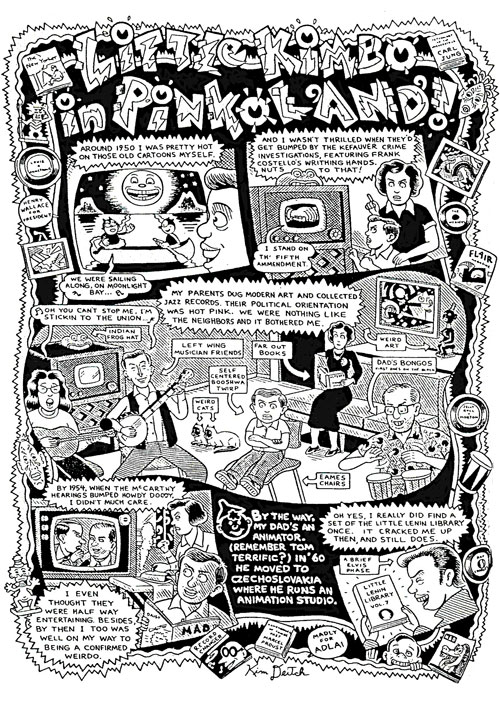
Williams: Have you seen any of his dad’s work?
Ware: Yeah.
Williams: I just saw an ad in the back of something that his dad drew, and it just blew me away.
Ware: I used to go to the U.T. (University of Texas) library, in Austin, and look at old issues of The Record Changer. Then I went there one day, and someone had stolen them all.
Williams: People shouldn’t steal from libraries... that’s bad (they should be shot!).
Ware: I agree.
Williams: Anything else you’d like to talk about? The world of politics?
Ware: No, not really. Terry Laban is good at that. He gives great interviews. A smart fella.
Williams: Jim Woodring is great in interviews. He comes off sounding so crazy. I want to strive for that. Do you like his stuff?
Ware: Yeah. I like his silent Frank things. It occurred to me one day that he and I do a similar thing. He does this silent, old, twenties looking cartoon character, walking around in a dumb landscape. Then he does things with words, about normal people. I thought, “Wait a minute!”
Williams: You guys both celebrate the medium, more than anything else. Rather than being ashamed of the fact that they’re comics, they are kind of, “Fuck you! This is comics.”

Ware: Well, I read and I look at the world more. I don’t have a TV. I haven’t had one for years now. I try to avoid that sort of thing, just ‘cause... I don’t want to see the world through TV’s eyes, which is what most people do. I want to see the world through my eyes. If I get ideas, I don’t want to get ideas from other ideas. I want to get ideas from the way someone has twisted a napkin, or buttoned their shirt, or twisted in their chair. Something like that, because those are real things. That’s the main problem with almost everything I see. It’s just a regurgitated version of what we’re already being fed. A lot of art, at least in the past few years, way up at the end of the twentieth century of modern art, all this post-modern art is just theoretical justifications for that sort of thing. It’s just the most inane sort of thing that can happen, and all of those things are going to be completely meaningless in a very short period of time. It has nothing to do with real life. I don’t understand it. I don’t see why if someone does a painting about The Flintstones, it’s supposed to be so great. They’re putting them into a religious setting to make it somehow... to make us aware of the fact that TV has ruined our lives. It’s got to be the most valueless statement that you can possibly make. People still feel shitty, cry. all that stuff. That’s what it’s about. I sound like an asshole... don’t print any of that.
Williams: No! It’s a great point.
Ware: Well, you can print whatever you want.
Williams: I would have gotten rid of my TV, but I’ve got a roommate who... it’s really dangerous when you’re a visual person. It gets in my way.
Ware: Well, even the way that things are blocked out on a television screen. If you carry those things over into a comic strip, they carry a particular emotional weight, that’s predetermined, but really has nothing to do with one’s own experience. When you’re talking with someone, at least if you’re trying to do it visually, they don’t really change in size a heck of a lot. If someone was as big while you were talking to them as they are in proximity on television or a movie, you’d be cleaning out their ear with your tongue, or something. That can work, but it has an intense impact. If you keep doing that in a comic strip, close-ups and that kind of thing, it just completely loses its weight. It’s like starting out a song playing the loudest thing you possibly can. It’s like you’ve blown all your options already. You don’t want to use up all your tricks at once. There’s a range there you kind of have to work within. I don’t know what the hell I’m talking about; I went to art school too long.
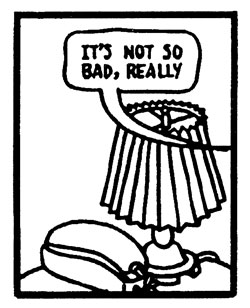
[Originally published in Destroy All Comics V.2 #1 in November of 1994]
Please note: about half of the images used in this interview are different than the images used in the original magazine publication. The reasons I had to use different images are either, the images that ran in the magazine originally didn't reproduce in sufficient quality to be posted online, or I couldn't find the same image elsewhere to re-scan, or I found better images than we were originally able to run in the magazine (for instance, images in color). The alternate images used, are hopefully all true to the spirit of the original, or improvements (such as being able to show a more readable Krazy Kat comic). All of the comics discussed in the article are worth googling, to see more and larger examples of the art. There are also a lot more reprints of much of this material available than there were in 1994, for instance the recent Happy Hooligan collection released by NBM. All non-labeled images are by Chris Ware.
ReplyDelete